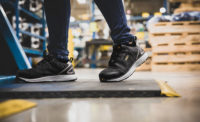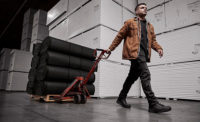Manufacturing and warehouse workers have specific footwear needs

Photo credit: KEEN Utility
The COVID-19 pandemic impacted industries across the globe, with e-commerce being no exception. In fact, e-commerce sales have soared, increasing by over 33% in 2020 and projecting to grow another 13% in 2021.1 With this steady growth in sales, it is clear the pandemic has signaled a paradigm shift in the way consumers shop.
However, while more consumers are buying goods effortlessly through their screens, a shift is also occurring in warehouse and distribution industries across the nation to fulfill the influx in orders. In response to keeping up with this newfound digital economy, employment rates in manufacturing skyrocketed during the pandemic, as 46,000 more employees joined this industry between February of 2020 to September of 2020 despite decreasing employment rates in a majority of other sectors.2 This rise in manufacturing is not expected to slow down anytime soon, as employment in hand laborers and material movers are projected to grow 7% between 2020 and 2030.3
With the recent boom in e-commerce now demanding additional employees for longer hours, the safety and comfort of those working in these labor intensive industries must be considered. This starts from the ground up. Proper work footwear can be key in protecting laborers from injuries and fatigue. Appropriate work shoes can lead to increased productivity and aid in the promotion of a positive work culture.
The importance of footwear
The increase in manufacturing and distribution has resulted in a workforce which has brought in many people who are new to these jobs as well as those who are continuing to work long, strenuous hours. Younger employees and those new to the workforce may be inclined to wear their normal sneakers or non-safety athletic footwear, but these types of shoes have not necessarily been designed for manufacturing or warehouse settings and may lack the support safety features required on the job. Many work environments require unique personal protective equipment that not only keeps workers safe, but can also provide comfort over the course of a long day of work.
Many of these jobs require workers to constantly be on their feet whether they are standing, moving, bending, or more. Personal Protective Equipment (PPE) footwear for these settings should provide responsive cushioning for hard, cement floors, a design that is both lightweight and breathable for comfort throughout an active day, and a slip-resistant outsole for sure footing. In some environments, protective toe caps may also be required. Because workers may not be aware of the footwear options with these safety and performance features, safety managers should educate and empower employees to choose PPE that will lead to a safer and more productive shift.
Trends and material innovations in safety footwear
The idea of safety footwear often conjures up images of boots that are large and bulky. However, the new reality is that many work shoes are now being designed with athletic silhouettes to both meet the demands of these movement intensive jobs as well as the personal preferences of those entering these industries. The result is the development of footwear that blends the lightweight fit and feel of a sneaker with the protection that comes with a more traditional safety boot.
These work sneakers are constructed with a blend of mesh and textiles to offer breathability as well as durability in high abrasion areas. It is also important that this kind of footwear is non-marring — in many manufacturing environments workers must be careful not to scratch or scuff any materials they may be producing. In addition to breathability and durability, knit work sneakers are also often equipped with waterproof linings and TPU webbing, which help to provide the additional structure and stability needed for long days on the job.
If a work sneaker is not providing enough support, new comfort enhancements, such as midsoles, provide additional performance cushioning through the use of proprietary compounds allowing workers to customize a shoe tailored to their needs for their job. Along with providing additional support, comfort features also help increase responsiveness, return energy with every step, and provide a lightweight feel. The result is PPE footwear that not only provides safety, but can lead to a more productive shift.
What to look for
Every jobsite is different, so selecting the right work shoe is not a one size fits all approach. Before choosing your work footwear, consider the hazards of any particular jobsite as well as requirements established by the company, the safety manager or regulatory bodies like OSHA. In order to maximize comfort and safety, there are a few factors to consider in a work shoe for indoor manufacturing and warehouse environments:
Slip-resistance: In settings where water, grease or any other liquids are common, it’s important for a shoe to have abrasion, oil- and-slip-resistant enhanced outsoles to prevent slipping. Shallow tread designs help to maximize surface area contact and siped channels along the tread disburse liquids, which will contribute to better surface area traction.
Cushioning: In addition to the right fit and slip-resistant outsoles, a work shoe should also cushion and support the foot. To ensure a work shoe is properly cushioned, it is important to feel the midsole of the shoe. Although a cushioned shoe will not reduce the force applied on the foot, it will increase the time taken for that force to apply, allowing the body to adapt. A cushioned shoe also supports the foot by aiding in the alignment of the foot when it touches the ground. If additional support is needed, arch supports can treat pain and other problems related to function of the foot and lower leg, along with further altering foot alignment and function.
Safety toes: When it comes to toe protection, it is also important to consider the safety caps in footwear. While steel toes are well known, there are now a variety of lightweight options available including aluminium and non-metallic composite or carbon-fiber safety toes. The latest safety toe to hit the market are carbon-fiber safety toe caps. They are 15% lighter than steel, and over the course of a day on your feet, this reduction in weight adds up. In addition to being lightweight, carbon-fiber safety toes are non-metallic allowing added convenience for workers who may have to pass through metal detectors throughout the work day. At my company, our safety toes are also asymmetrical allowing for a roomier and less obtrusive fit that contours to the natural shape of the foot and allows toes and feet to flex more naturally.
Fit matters: For jobs that require constant moving or standing, finding a work shoe that fits well is also crucial in order to feel comfortable, maximize performance, and prevent injuries. To ensure the best fit, you should try on shoes with the socks that you will be wearing during a shift. Feet naturally swell throughout the course of the day so we also recommend trying new shoes on after a shift when feet are at their largest.
Proper fit extends beyond finding your right size, especially where women are concerned. This growing segment of professionals has historically been under-represented when it comes to proper fitting PPE, including footwear. In the past, women in the trades have been forced to find the smallest men’s size or settle for ill-fitting footwear. Today many footwear brands are working to be more inclusive when it comes to product development for all. My company, as an example, has created a tradeswomen tested program where on-the-job feedback from women in the trades is integrated into product conception all the way through product release.
Looking ahead
In order to keep up with the growing e-commerce landscape, the health and safety of workers in these rising manufacturing and distribution industries must be prioritized. This includes making sure this workforce is properly outfitted to succeed on the job and that includes appropriate footwear. With recent developments and innovations, the PPE footwear that is available today offers a variety of safety, comfort, and performance enhancements.
While no pair of feet are the same and different jobs have different requirements, the right shoe provides support, balance, and mobility which allows workers to feel comfortable and be more protected. Since the high turnaround rate in manufacturing jobs is partially due to physical demands from the job, a great first step starts with empowering the workforce with the best work footwear possible that meets the demands of the job and supports them throughout their shift.
References
- 1. “Quarterly Retail E-Commerce Sales 3rd Quarter 2021.” U.S. Census Bureau News, November 18, 2021, https://www.census.gov/retail/mrts/www/data/pdf/ec_current.pdf
- 2. “About the Warehouse and Storage Subsector.” U.S. Bureau of Labor Statistics, November 19, 2021, https://www.bls.gov/iag/tgs/iag493.htm
- 3. “Hand Laborers and Material Movers.” U.S. Bureau of Labor Statistics, September 13, 2021, https://www.bls.gov/ooh/transportation-and-material-moving/hand-laborers-and-material-movers.htm
Looking for a reprint of this article?
From high-res PDFs to custom plaques, order your copy today!






